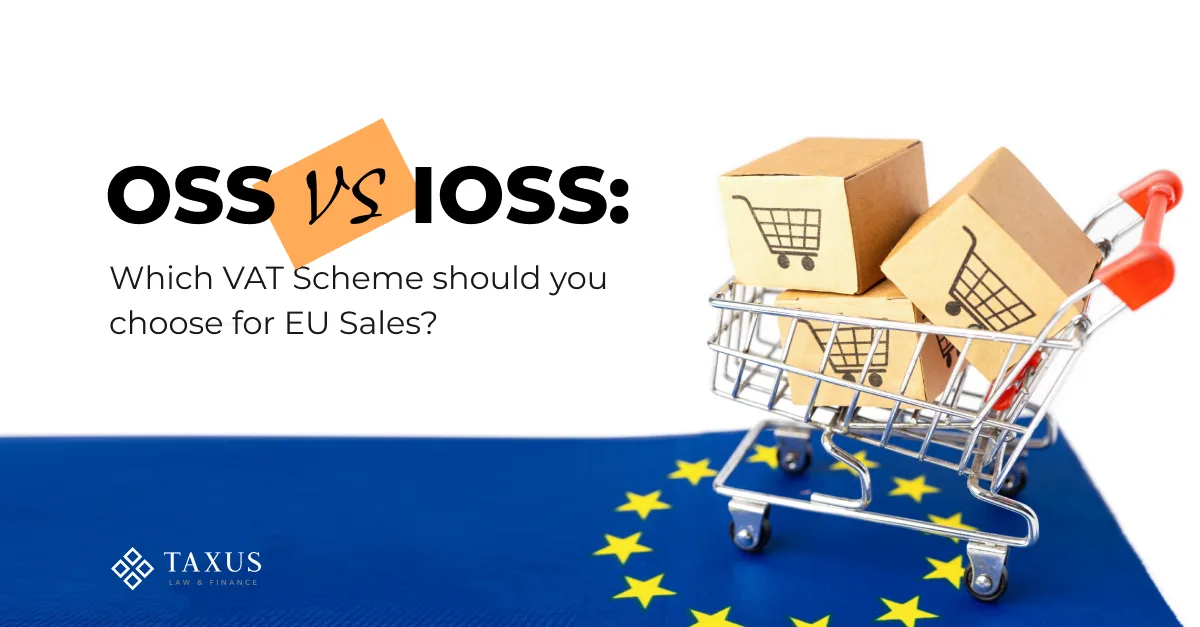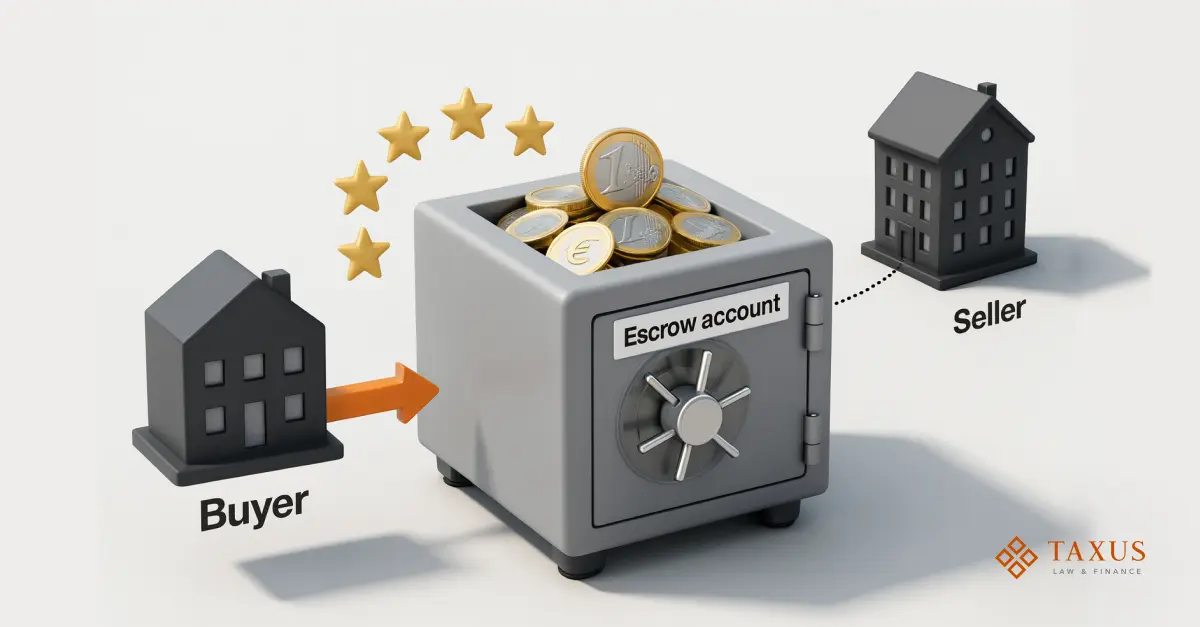OSS vs IOSS: Which VAT Scheme Should You Choose for EU Sales?

O. Chudakova

Why Choosing the Right Scheme Matters for Your EU Business
EU VAT for eCommerce sellers can be a maze – especially once you start cross-border sales. Picking the right VAT scheme for EU sales is what keeps your checkout smooth, your compliance clean, and your margins intact. The OSS vs IOSS difference comes down to where the goods are and how they enter the EU market: One-Stop Shop vs IOSS are streamlined EU VAT registration schemes designed to cut paperwork, reduce duplicate registrations, and centralize reporting. Choose well and you’ll simplify filings, avoid double-charging VAT, and prevent delivery delays or surprise customs costs for customers.
In this guide, we’ll explain what is OSS in VAT, what is IOSS in EU sales, and how to choose OSS or IOSS for your specific scenario – using plain language and practical examples.
What is OSS (One-Stop Shop)?
OSS is an EU VAT scheme for eCommerce that lets you report cross-border B2C distance sales within the EU through a single EU VAT return. Instead of registering for VAT in every Member State where you have customers, you register once, file one quarterly return, and pay VAT via one EU portal. It’s designed to cut admin and keep EU VAT compliance simple for online sellers.
Who can use it?
EU and non-EU businesses that make B2C distance sales of goods (and certain services) to consumers in other EU countries.
How it works (in practice):
- Single registration in one Member State (your Member State of Identification).
- One consolidated VAT return covering all EU countries of consumption.
- One payment through the portal; tax authorities distribute VAT to each country.
Example:
If your warehouse is in Germany and you sell to customers in France, Spain, and Italy, you can declare all those intra-EU B2C sales via OSS – no separate VAT registrations in each country.
OSS simplifies EU VAT for eCommerce with centralized registration and reporting, which is a win for brands with broad EU market coverage looking to reduce filings and avoid multi-country admin.
What is IOSS (Import One-Stop Shop)?
IOSS is the EU VAT scheme for low-value imports that lets you collect VAT at checkout on goods up to €150 shipped from outside the EU to EU consumers. To enable destination VAT at checkout and automate the flow, make sure your payment solution supports IOSS mapping and country-specific VAT rates. By using a single IOSS registration number, you file one monthly EU VAT return and your parcels clear customs without extra VAT or handling fees on delivery – a big boost to customer experience.
Who can use it?
- Non-EU sellers shipping B2C orders to the EU
- Online marketplaces/platforms (they can be deemed suppliers)
- Intermediaries representing non-EU sellers for IOSS
How IOSS works (in practice):
- Scope: Physical goods valued ≤ €150 per consignment (no excise goods).
- VAT collected at checkout: You charge the destination country VAT rate when the customer pays.
- Single monthly return: Report all IOSS sales via one EU portal; tax is distributed to each Member State.
- Fast customs release: Parcels are tagged with your IOSS number, so they pass customs without additional VAT/clearance fees on arrival.
Example
A US merchant sells a €40 phone accessory to an EU buyer. With IOSS, the EU VAT is charged at checkout, the parcel is pre-cleared using the IOSS number, and the customer receives the package with no surprise fees at the door.
Why it matters
IOSS improves conversion and trust by removing unexpected delivery charges and delays. For merchants comparing OSS vs IOSS, remember:
IOSS = imports into the EU (≤ €150);
OSS = intra-EU distance sales.
Together, they simplify EU VAT compliance for eCommerce.
OSS vs IOSS: Key Differences
Below is a quick, skimmable comparison for merchants searching “OSS vs IOSS,” “Which EU VAT scheme should I choose,” and “EU VAT for eCommerce.”
| Dimension | OSS (One-Stop Shop) | IOSS (Import One-Stop Shop) |
| What it covers | Intra-EU B2C distance sales of goods (and certain services) when goods are already inside the EU. | B2C imports into the EU of low-value goods ≤ €150 shipped from outside the EU. |
| Who can use | EU and non-EU businesses selling cross-border within the EU. | Non-EU sellers, online marketplaces (deemed supplier), or intermediaries for non-EU sellers. |
| VAT timing | VAT charged at checkout at the destination country rate; reported centrally. | VAT collected at checkout at the destination rate; pre-declared for customs. |
| Returns & frequency | One quarterly return via your Member State of Identification. | One monthly return via the IOSS portal (through an intermediary if required). |
| Customs impact | Not a customs program (goods already in the EU). | Speeds customs: parcels move without extra VAT/handling fees on delivery when an IOSS number is used. |
| Value limits | No €150 cap (standard VAT rules apply). | Limited to consignments ≤ €150 (no excise goods). |
| Registrations saved | Avoids multiple VAT registrations in each country of consumption. | Avoids ‘VAT at the door’ charges and courier handling fees for low-value imports. |
| Typical use case | You store/fulfil from an EU warehouse and ship B2C across Member States. | You ship direct from a non-EU country to EU consumers with low-value orders. |
Quick VAT Scheme Consultation
How to Choose: OSS or IOSS?
Use this quick, practical framework to decide which EU VAT scheme you should choose for EU eCommerce – OSS vs IOSS – based on how and from where you ship.
1) Start with your logistics model
- You ship from inside the EU (EU warehouse/fulfilment center) to EU consumers → Use OSS (Union OSS) for intra-EU B2C distance sales.
- You ship from outside the EU directly to EU consumers and most orders are low-value (≤ €150) per consignment → Use IOSS to collect VAT at checkout and speed customs.
- You do both (EU stock + non-EU direct) → You’ll likely use both schemes: OSS for EU-to-EU distance sales, IOSS for non-EU → EU ≤ €150 imports.
2) Check order values & product types
- Typical basket ≤ €150 (e.g., accessories, cosmetics, small electronics): IOSS is ideal for non-EU shipments.
- Frequent orders > €150 or excise goods: IOSS cannot be used. Ship DDP with standard import VAT/clearance, or hold EU stock and sell via OSS.
- Mixed baskets: If an order exceeds €150, that consignment doesn’t qualify for IOSS.
3) Think through compliance scope (what OSS/IOSS do not replace)
- Domestic VAT in your warehouse country still applies; OSS doesn’t replace your local VAT number for domestic sales, stock movements, or returns.
- IOSS only covers imported B2C consignments ≤ €150. It doesn’t cover returns of EU-stock orders, B2B sales, or consignments over the cap.
- Filing cadence: OSS = quarterly, IOSS = monthly. Plan your finance ops accordingly.
4) Decision shortcuts. Choose OSS or IOSS?
- EU warehouse → EU consumers ⇒ Use OSS (EU VAT for eCommerce, distance sales).
- Non-EU warehouse → EU consumers, ≤ €150 ⇒ Use IOSS (collect VAT at checkout, faster customs).
- Both routes ⇒ Use both (OSS for EU-held stock; IOSS for low-value imports).
5) Typical scenarios:
- Dropship from China/US to EU, AOV ≈ €30–€80 → IOSS (reduce “VAT at the door”, higher conversion).
- D2C brand with 3PL in Germany shipping across EU → OSS (one consolidated EU VAT return for distance sales).
- Hybrid brand (EU 3PL + global dropship) → OSS + IOSS (map SKUs/flows to the right scheme).
- Orders often > €150 → Consider EU stocking + OSS or DDP with standard import VAT (IOSS not available).
6) Operational checklist before you commit
- Map your shipping flows (origin, destination, values).
- Estimate order value distribution (what % ≤ €150).
- Confirm marketplace roles (are they the deemed supplier?).
- Plan filings & cash flow (OSS quarterly, IOSS monthly).
- Set up systems (rate calculation by destination, IOSS number on labels, returns handling, credit notes).
- Document exceptions (orders > €150, B2B, excise).
Common Mistakes Entrepreneurs Make
- Registering in the wrong country → risk of double VAT.
- Ignoring IOSS for imports → extra customs/handling fees for customers.
- Confusing OSS with classic VAT registration → compliance gaps and misfilings.
- Underestimating marketplace rules – on major platforms like Amazon or eBay, VAT obligations can shift to the marketplace as a deemed supplier. Misjudging this can lead to unnecessary costs.
⚠️ Note: Always analyze your sales model before choosing a scheme to avoid extra spend. Look closely at logistics routes, countries of supply, and end customers when deciding between OSS vs IOSS.
Practical Registration Tips (OSS / IOSS)
- Confirm eligibility – map your sales flows and decide between OSS vs IOSS to keep EU VAT for eCommerce compliant.
- Prepare documents early – have company details and sales/logistics info ready to speed up One-Stop Shop or Import One-Stop Shop onboarding.
- If you’re a non-EU seller using IOSS, appoint an EU-based intermediary – this keeps IOSS registration and filings smooth.
- Keep accurate records – clean order data and VAT summaries make OSS (quarterly) and IOSS (monthly) reporting straightforward.
- Check marketplace rules – on platforms like Amazon or eBay, VAT obligations may shift to the marketplace as a deemed supplier; align your process accordingly.
- Monitor EU updates – VAT rates and guidance change; review official notices to stay current and avoid surprises.
Conclusion
Both OSS and IOSS are designed to simplify EU VAT administration for online sales. Your choice depends on the flow of goods: whether you sell within the EU (intra-EU distance sales) or import goods from outside the EU. Picking the right EU VAT scheme helps you stay compliant, improves customer experience, and saves time.
In more complex setups – e.g., when a company stores stock in the EU and ships low-value parcels from China/other non-EU countries – you’ll often need to use both schemes: OSS for EU-to-EU distance sales and IOSS for non-EU → EU consignments ≤ €150. This reduces risk and keeps reporting transparent with tax authorities.
Hybrid models often need both tracks: EU stock via OSS (start with company registration) and non-EU low-value imports via IOSS.
👉 To avoid errors and penalties, consider working with experts who can guide your OSS/IOSS selection and registration, set up correct EU VAT for eCommerce workflows, and ensure smooth One-Stop Shop / Import One-Stop Shop reporting.
FAQ
What does IOSS mean?
IOSS (Import One-Stop Shop) is the EU VAT scheme for low-value imports that lets sellers charge VAT at checkout on consignments up to €150 shipped from outside the EU.
What is OSS in VAT?
OSS (One-Stop Shop) allows sellers to report all intra-EU B2C distance sales via a single VAT registration and one quarterly return, instead of registering in each Member State.
What is IOSS in the UK?
The UK is no longer part of the EU VAT system, but UK sellers can still use IOSS by appointing an EU-based intermediary to register and file monthly IOSS returns for sales to EU consumers.
Can I use both OSS and IOSS?
Yes. If you make intra-EU distance sales and import low-value goods into the EU, you can run OSS and IOSS in parallel (OSS for EU-to-EU sales, IOSS for ≤ €150 non-EU → EU imports).
Which EU VAT scheme should I choose for EU sales?
- Selling within the EU (EU warehouse → EU consumers): choose OSS.
- Importing goods ≤ €150 into the EU (non-EU origin → EU consumers): choose IOSS.
For hybrid models, use both.

Turnkey eCommerce Setup

Looking for a reliable payment processing system?
Order selection of a payment solution.









